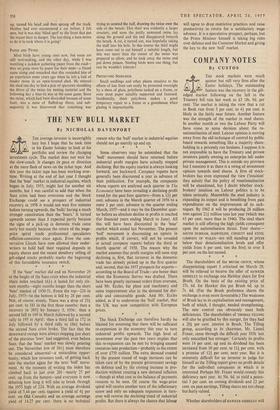THE NEW BULL MARKET
By NICHOLAS DAVENPORT THE average investor is incorrigibly lazy but I hope that he took time in his Easter holiday to look at his portfolio and review the changing
investment cycle. •The market does not wait for the slow-coach. It changes its pace or direction at the mere flash of news on the ticker tape. And this year the ticker tape has been working over- time. Writing at the end of last year I thought that the 'bear' market in industrial equities, which began in July, 1955, might last for another six months, but I was careful to add that when the Suez crisis had been overcome and the Stock Exchange could see a prospect of industrial recovery in 1958 it would not wait five minutes before turning upwards, the 'bulls' having a much stronger constitution than the 'bears.' It turned upwards sooner than I expected partly because the signs of a pick-up in domestic trade came early but mainly because the return of the wage- price spiral made professional speculators inflation-conscious once again. Even the con- servative Lloyds have now allowed their under- writers to hold half their required deposits in equity shares and the recent desultory selling of gilt-edged stocks probably marks the beginning of this formidable insurance switch.
If the 'bear' market did end on November 29 at the height of the Suez crisis when the industrial share index touched 1614 it lasted for only six- teen months—eight months longer than the short 'bear' market of 1950-51. From the top-224 in July, 1955—to the bottom it fell by 28 per cent. Not, of course, evenly. There was a drop of 234 per cent. to 181 in the first three months; then a recovery to 2034 by January 3, 1956: then a second fall to 169 in March followed by a second rally to 195 in April : then a third fall to 172 in July followed by a third rally to 1864 before the second Suez crisis broke. The fact that the downward swings were always stopping just short of the previous 'lows' had suggested, even before Suez, that the 'bear' market was slowly petering out. The November low of 1614 must therefore be considered abnormal—a miraculous oppor- tunity, which few investors took, of getting back into the market again for the next 'bull' move- ment. At the moment Of writing the index has climbed back to just over 201—nearly 25 per cent, up from the bottom—and everyone is now debating how long it will take to break through the 1955 high of 224. With an average dividend yield of 5.44 per cent. (against a yield of 44 per cent. on Old Consols) and an average earnings yield of 14.27 per cent, there is no technical
reason why the 'bull' market in industrial equities should not go merrily up and up.
Some observers may be astonished that the 'bull' movement should have returned before industrial profit margins have actually stopped declining. But the equity market is always looking forward, not backward. Company reports have generally been discounted a year in advance of their publication. For example, the companies whose reports are analysed each quarter in The Economist have been revealing a declining profit trend for the past four quarters—from a 124 per cent. advance in the March quarter of 1956 to a mere 1 per cent, advance in the quarter ending March, 1957—and it may be the December quar- ter before an absolute decline in profits is reached (for financial years ending March to June). All this will have been discounted in the 'bear' market which ended last November. The present 'bull' movement is discounting an upturn in profits which, if correct, will not be revealed in actual company reports before the third or fourth quarter of 1958. The reason why the market assumes that profit margins will soon stop declining is, first, that turnover in the domestic trade has already picked up in the first quarter and, second, that the 1957 prospects for exports— according to the Board of Trade—are better than when the Economic Survey was drafted. There have been greatly increased orders from overseas, said Mr. Eccles, for plant and machinery and some improvement also in the demand for dur- able and consumable goods. And Mr. Eccles added, as if to underwrite the 'bull' market, that the UK was now competitive with European prices.
The Stock Exchange can therefore hardly be blamed for assuming that there will be sufficient re-expansion in the economy this year to turn industrial profits upwards. The high level of investment over the past two years implies that this re-expansion can be met by bringing unused resources into production—probably to the extent of over £750 million. The extra demand created by the present round of wage increases can be taken care of by the present government savings on defence and by the coming increase in pro- duction without creating a new demand inflation —though at what cost to the balance of payments remains to be seen. Of course the wage-price spiral will receive another turn of the inflationary screw and only an adequate expansion in turn- over will reverse the declining trend of industrial profits. But there is always the chance that labour will agree to drop restrictive practices and raise productivity in return for a satisfactory wage - advance. It is a speculative prospect, perhaps, but the Prime Minister himself is taking big risks over defence and the Common Market and giving the key to the new 'bull' market.






























 Previous page
Previous page